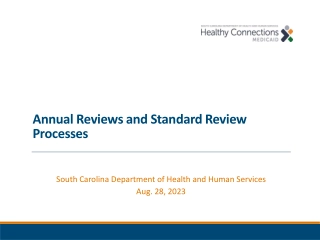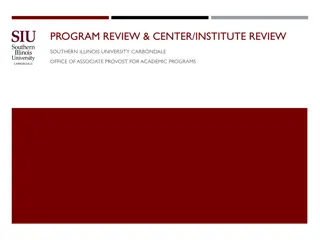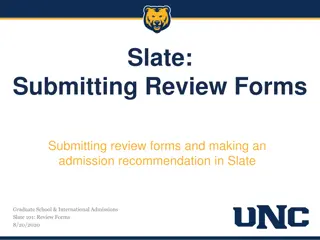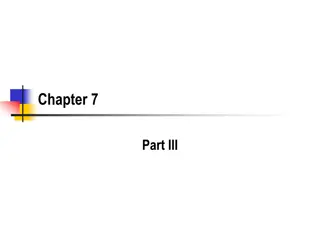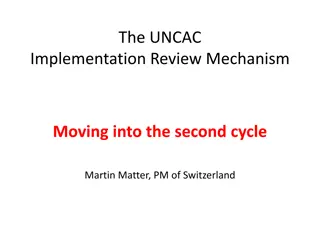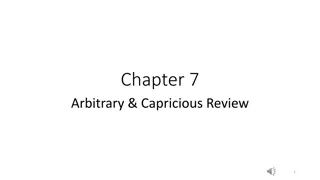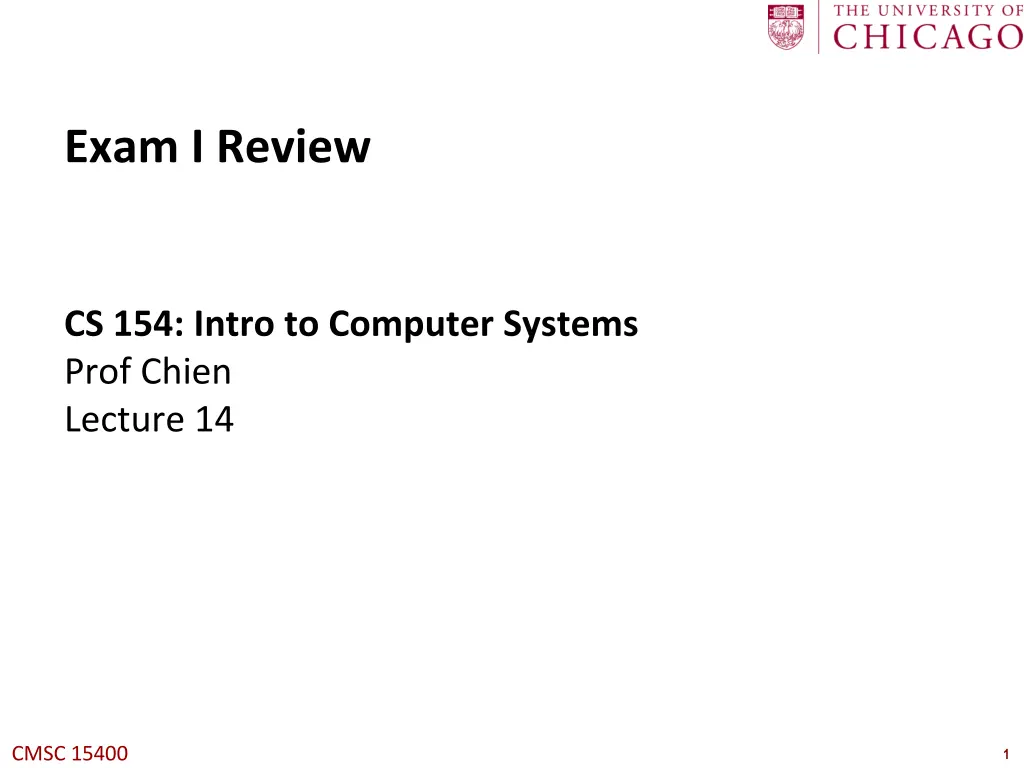
Computer Systems Exam Review: Topics, Logistics, and Memory Organization
Get ready for your computer systems exam with a comprehensive review covering topics like number representation, memory organization, byte ordering, and integer encoding. Find out exam logistics and important details for Exam 1, including review session information and what to expect during the test.
Uploaded on | 1 Views
Download Presentation

Please find below an Image/Link to download the presentation.
The content on the website is provided AS IS for your information and personal use only. It may not be sold, licensed, or shared on other websites without obtaining consent from the author. If you encounter any issues during the download, it is possible that the publisher has removed the file from their server.
You are allowed to download the files provided on this website for personal or commercial use, subject to the condition that they are used lawfully. All files are the property of their respective owners.
The content on the website is provided AS IS for your information and personal use only. It may not be sold, licensed, or shared on other websites without obtaining consent from the author.
E N D
Presentation Transcript
Exam I Review CS 154: Intro to Computer Systems Prof Chien Lecture 14 CMSC 15400 1
Exam 1 Logistics Covers materials through Today s Lecture, Lecture #14 (Review) November 4th, Monday, 7pm-8:30pm, KPTC (Kersten Physics Teaching Center) Room 106 Exam Logistics closed everything Can bring one handwritten sheet of paper x86 instruction list will be on the exam paper https://www.classes.cs.uchicago.edu/current/15400-1/154-exam1- cheatsheet.pdf Review Session, Saturday 3-5pm, Crerar 346 SDS students only: see email from Daniar Kurniawan (daniar@uchicago.edu) CMSC 15400 2
Exam I Topics Representation of Numbers Integer Arithmetic What is Architecture Basic x86-64 instructions Control Flow Procedures Arrays, Structs, Unions Memory Hierarchy and Caching CMSC 15400 3
Memory Organization 64-bit Words Bytes Addr. Addresses specify byte locations Address of first byte in word Addresses of successive words differ by 4 (32-bit) or 8 (64-bit) 0000 0001 0002 0003 0004 0005 0006 0007 0008 0009 0010 0011 0012 0013 0014 0015 Addr = ?? 0000 Addr = ?? 0008 CMSC 15400 4
Byte Ordering How should bytes be ordered in memory? Little Endian: Least significant byte has lowest address Big Endian: Least significant byte has highest address int x = 0x01234567 0x00 0x01 0x02 0x03 01 23 01 23 Big Endian 45 45 67 67 0x00 0x01 0x02 0x03 67 45 67 45 Little Endian 23 23 01 01 short a[] = {0x0123, 0x4567} 0x00 0x01 0x02 0x03 01 23 01 23 a[0] = 0x0123 Big Endian 45 45 ((char*)a)[1] = 0x23 67 67 0x00 0x01 0x02 0x03 67 45 23 01 Little Endian 23 67 01 45 ((char*)a)[1] = 0x01 a[0] = 0x0123 CMSC 15400 5
Encoding Integers Unsigned Two s Complement w 1 w 2 xw 1 2w 1+ xi 2i xi 2i = = B2U(X) B2T(X) i=0 i=0 Sign Bit Sign Bit For two s complement, most significant bit indicates sign 0 for nonnegative 1 for negative But it is NOT the case that changing the sign bit merely changes the sign of the represented value CMSC 15400 6
Bits, Bytes & Integers Know how to do basic bit operations Shifting, addition, negation, and, or, xor, etc. If you have w bits What are the largest/smallest representable signed numbers? What are the largest/smallest representable unsigned numbers? What happens to the bits when casting signed to unsigned (and vice versa)? Distinguish between logical and bitwise operators (e.g., & vs &&) When does (signed, unsigned) overflow happen? Bit-level behavior is the same for signed and unsigned. CMSC 15400 7
Computer Architecture imull Hardware (Processor + Memory) The architecture is the xorl interface between software and hardware movq State - contents of memory leaq (Note: different architectures may have different kinds of memory) Methods - change memory CMSC 15400 8
Instruction Set Elements Operations Condition codes and conditional jumps Addressing modes for Memory Procedure call/return + relationship to C source code CMSC 15400 9
Software View of Architecture State Memory CPU Addresses Registers Object Code Program Data OS Data PC Data Condition Codes Instructions ALU Stack Programmer-Visible State PC: Program counter Heap Address of next instruction Called RIP in x86-64 Register file Memory Heavily used program data Condition codes Byte addressable array Code, user data, (some) OS data Store status information about most recent arithmetic operation Includes stack used to support procedures Used for conditional branching CMSC 15400 11
A Very Simple Program (1+2 = 3, stored at 0x11c) Address 0x124 0x01 0x02 0x120 0x11c %rax 0x124 0x118 %rdx 0x120 0x114 0x110 %rcx 0x11c ALU 0x10c %rbx 0x108 %rsi 0x104 %rdi 0x100 %rsp movq (%rax), %rbx addq (%rdx), %rbx movq %rbx, (%rcx) %rbp 0x104 CMSC 15400 12
A Very Simple Program (1+2 = 3) Address 0x124 0x01 0x02 0x120 0x11c %rax 0x124 0x118 %rdx 0x120 0x114 0x110 %rcx 0x11c ALU 0x10c %rbx 0x01 0x108 %rsi 0x104 %rdi 0x100 %rsp movq (%rax), %rbx addq (%rdx), %rbx movq %rbx, (%rcx) %rbp 0x104 CMSC 15400 13
A Very Simple Program (1+2 = 3) Address 0x124 0x01 0x02 0x120 0x11c %rax 0x124 0x118 %rdx 0x120 0x114 0x110 %rcx 0x11c ALU 0x10c %rbx 0x03 0x108 %rsi 0x104 %rdi 0x100 %rsp movq (%rax), %rbx addq (%rdx), %rbx movq %rbx, (%rcx) %rbp 0x104 CMSC 15400 14
A Very Simple Program (1+2 = 3) 0x124 0x01 0x02 0x120 0x03 0x11c %rax 0x124 0x118 %rdx 0x120 0x114 0x110 %rcx 0x11c ALU 0x10c %rbx 0x03 0x108 %rsi 0x104 %rdi 0x100 %rsp Address movq (%rax), %rbx addq (%rdx), %rbx movq %rbx, (%rcx) %rbp 0x104 CMSC 15400 15
For loop example int array_mul( int* A, int* B, long n){ int val = 0; int i; for (i = 0; i != n; i++){ val += A[i]*B[i]; } return val; } array_mul: movq movq jmp .L3: movl imull (%rsi,%rcx,4), %r8d addl %r8d, %eax addq $1, %rcx .L2: cmpq %rcx, %rdx jne .L3 .L4: ret $0, %rax $0, %rcx .L2 (%rdi,%rcx,4), %r8d CMSC 15400 16
Assembly: Basics, Loops Recognize common assembly instructions Understand how different control flow is turned into assembly For, while, if-else, etc Be very comfortable with pointers and dereferencing The use of parens in mov commands. %rax vs. (%rax) The options for memory addressing modes: D(Rb, Ri, S) leaq vs. movq CMSC 15400 17
x86-64/Linux Stack Frame Caller Stack Frame Return address Pushed by call instruction Arguments for this call (optional) Caller Frame Argument build (Optional) Return Addr Callee Stack Frame Saved register context Local variables If can t keep in registers Arguments for function about to call (optional) Saved Registers + Local Variables Callee Frame Argument build (Optional) Stack pointer %rsp CMSC 15400 18
Carnegie Mellon x86-64 Linux Register Usage #1 %rax Return value Also caller-saved Can be modified by procedure %rax %rdi %rsi Return value %rdx %rcx %r8 %r9 %r10 %r11 %rdi, ..., %r9 Arguments Also caller-saved Can be modified by procedure Arguments %r10, %r11 Caller-saved Can be modified by procedure Caller-saved temporaries CMSC 15400 19
Carnegie Mellon x86-64 Linux Register Usage #2 %rbx %r12 %r13 %r14 %rbx, %r12, %r13, %r14 , %rbp Callee-saved Callee must save & restore Callee-saved Temporaries %rsp Special form of callee save Restored to original value upon exit from procedure %rbp %rsp Special CMSC 15400 20
Assembly Stack How arguments are passed to a function? How does a function pass the return value? How these instructions modify stack call ret pop push cs154 21 21
Carngie Mellon Array Access Understand how in assembly, a logical 2D array is implement as a 1D array, using the width of the array as a multiplier for access CMSC 15400 22
Carngie Mellon Memory Hierarchy and Locality Cache: A smaller, faster memory that acts as a staging area for a subset of the data in a larger, slower memory (DRAM) For each k, the faster, smaller device at level k serves as a cache for the larger, slower device at level k+1. Why do memory hierarchies work? Because of locality, programs tend to access the data at level k more often than they access the data at level k+1. Thus, the storage at level k+1 can be slower, and thus larger and cheaper per bit. CMSC 15400 23
Carngie Mellon Locate set Check if any block in set has matching tag Yes + block valid: hit Locate data starting Cache Basics E = 2e blocks per set Address of word: at offset address of word: m bits t bits s bits b bits S = 2s sets set index block offset tag data begins at this offset tag B-1 v 0 1 2 valid bit B = 2b bytes per cache block (the data) CMSC 15400 24
Carngie Mellon Cache Basics Block Placement: Where can a block be placed in the cache? Block Identification: How a block is found if it is in the cache? Block Replacement: Which block should be replaced on a miss? Write Strategy: What happens on a write? First example of microarchitecture What is microarchitecture and how is it different from architecture (ISA)? CMSC 15400 25
Carngie Mellon Filter Example int filter[4]; apply_filter: int apply_filter(int* in) { int i; int x = 0; movq movq $0, %rax $0, %rdx .L2: for(i = 0; i < 4; i++) { x += in[i]*filter[i]; } movl imull filter(,%rdx,4), %ecx addl %ecx, %eax addq $1, %rdx cmpq $4, %rdx jne .L2 ret (%rdi,%rdx,4), %ecx return x; } CMSC 15400 26
Carngie Mellon Address Trace Address %rdi 0x10 filter 0x00 0x04 0x08 0x0C movl (%rdi,%rdx,4), %ecx imull filter(,%rdx,4), %ecx 0x10 0x14 0x18 %rdx i 0 1 2 3 filter(,%rdx,4) &filter[i] 0x00 0x04 0x08 0x0C (%rbx,%rdx,4) &in[i] 0x10 0x14 0x18 0x1C 0x1C CMSC 15400 27
Carngie Mellon Cache Performance Analysis Derive memory traces from assembly You need to know assembly, recognize pointer references (both read and write), recognize loops, function calls, etc. For each access, hit or miss? You need to know the basics of caching If cache performance is not good (e.g., low hit rate), how can you make it better? You need to know the tradeoffs of different cache designs: bigger cache? Higher associativity? Larger block size? CMSC 15400 28
Carngie Mellon Exam I Topics Representation of Numbers Integer Arithmetic What is Architecture Basic x86-64 instructions Control Flow Procedures Arrays, Structs, Unions Memory Hierarchy and Caching CMSC 15400 29


